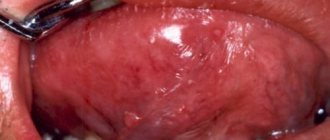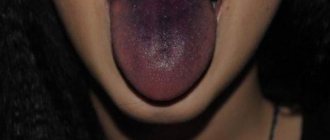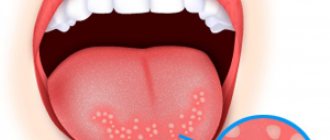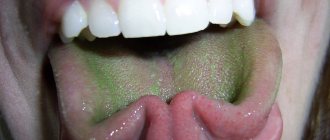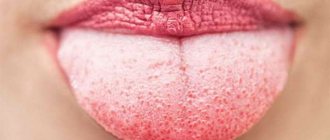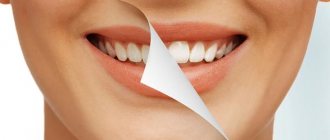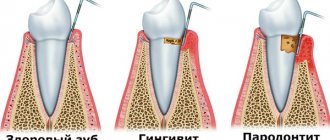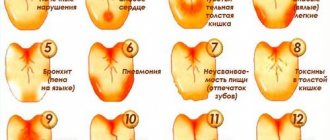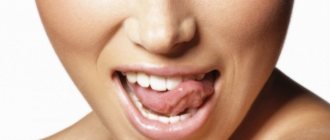The color of the tongue tends to change. The resulting plaque most often signals the presence of problems with internal organs.
There are a great many reasons for the appearance of such a symptom, and the deposit itself can have a different color. Let's consider typical situations for diagnosing and treating this problem.
Causes and symptoms of a yellow coating on the tongue
The appearance of the tongue lets you know about the integrity and functioning of the internal organs. In normal condition, there is a barely noticeable translucent or white-yellow coating on its surface.
But the appearance of a noticeable yellow deposit indicates a malfunction in the functioning of the gastrointestinal tract or liver.
Plus, based on how visible it is, you can determine the stage of health problems:
- The normal causes of this problem are physiological and climatic features.
A coating of light shades indicates the onset of the disease.
- Dark colors indicate advanced pathology.
Let's start with the harmless factors. The normal causes of this problem are physiological and climatic characteristics.
Often the tongue becomes white-yellow:
- During the heat.
- When using a number of medications (usually this leads to the use of antibiotics).
- Due to eating colored foods.
Having eliminated them, after a while the language returns to its normal state.
Yellow plaque can appear due to many reasons. The top layer has a mucous membrane. It is covered with papillae, through which the taste of food is perceived. Her epithelium can grow, so the color of the plaque also changes.
The process intensifies when:
- Inflammation of the mucous membrane of the tongue.
- Damage and irritation of the surface of the tongue due to mechanical, thermal and chemical effects.
- Development of acute and chronic pathologies in the gastrointestinal tract.
Causes of plaque on the tongue in adults
Liver diseases
Liver cirrhosis and hepatitis can lead to a yellow tongue
The most common reason for the formation of colored plaque is associated with impaired pigment metabolism that occurs against the background of inflammation or infection.
As a result, the pathological process affects healthy tissues, which acquire a yellow color.
Liver cirrhosis and hepatitis can lead to this. These problems affect older people, and the disease itself is usually very difficult to cope with.
Gallbladder diseases
Stagnation of bile or cholestasis (damage to the ducts that remove bile from the body) is characterized by the following: the tongue acquires a characteristic color due to inflammation of the gallbladder, cholelithiasis, in which fluid begins to be retained in the body.
The pathology is quite rare, but when present, it slows down the removal of harmful substances from the body.
The color also changes if the gallbladder is curved abnormally. This anomaly is characterized by the structure of the organ in which it becomes deformed over time.
This leads to malfunction of the gallbladder. The cause of plaque may also be the removal of this organ.
Adrenal disease
We are talking about suprahepatic jaundice. Plaque on the tongue is formed due to the increased secretion of bilirubin and the content of red blood cells in the body (which is confirmed by the results of blood tests) exceeding the norm.
Moreover, they do not have time to hatch. This can also be caused by an overdose of sulfonamides, impaired synthesis of red blood cells, previous heart attacks, and chemical poisoning.
This disease is classified as infectious. The color of the mucous membrane and skin changes. A pale color appears in healthy tissues. By palpation, you can see the expansion of the spleen.
Problems with the gastrointestinal tract
If there is a possibility of damage to the gastrointestinal tract, the patient is referred for an ultrasound scan of internal organs and a stool test. Having received the results, the doctor pays attention to the presence of helminths (another sign of their presence is a cough in a patient who does not suffer from a cold).
The following lesions fall into this category:
- If there is a possibility of damage to the gastrointestinal tract, the patient is referred for an ultrasound scan of internal organs and a stool test
Duodenogastric reflux. A syndrome manifested by gastritis, duodenitis and stomach ulcers. DGR is characterized by the fact that bile from the duodenum penetrates into the stomach cavity.
- Particularly prominent is chronic gastritis , affecting the elderly and middle-aged population. Characteristic symptoms (yellow tongue and others) persist with a person until old age, and the disease itself makes itself felt in waves. Since this form occurs when a previously acute pathology was not completely cured, it is almost impossible to overcome the disease.
- Aggravated form of pancreatitis.
- Stomach diseases (chronic gastritis, gastrointestinal and duodenal ulcers, etc.).
- Parasitic infections affecting the bile ducts, duodenum and liver.
Respiratory diseases
Respiratory and viral diseases that develop with hyperthermia, which leads to dehydration (most often this is what leads to the formation of plaque).
For example, color changes with sore throat. An important symptom is the presence of elevated temperature for a long period of time.
Inflammation of the tongue
Children are most susceptible to inflammation of the tongue (aphthous stomatitis, glossitis of bacterial and fungal origin).
Usually it occurs as a result of inflicted injuries, which the enthusiastic child does not even feel until the lesion affects most of the healthy tissue.
Medicines
Having established the nature of plaque formation, the doctor can develop treatment.
It includes taking the following medications:
- Determining whether food is causing the film is quite simple: clean your tongue after eating and see if you get rid of the plaque.
Choleretic agents that remove accumulated waste from the body.
- Antibiotics (macrolides, cephalosporins and tetracyclines).
- Hepatoprotectors.
- Antiviral and antifungal agents.
- Dopamine blockers.
- Adsorbents.
- Vitamins (usually a whole complex).
- Taking glucose and electrolyte solutions.
Typically the patient is referred to:
- To the dentist.
- Gastroenterologist.
Coloring products and bad habits
Lovers of strong tea and coffee who consume these drinks in large quantities every day will inevitably notice the appearance of a yellow-brown layer of plaque on the tongue.
This pattern also applies to people who smoke (especially if they consume non-filtered cigarettes). Other products - apricot, carrots, pumpkin, etc. – also differ in their characteristic color after taking them.
Determining whether food is the cause of the film is quite simple: clean your tongue after eating a soft amount and see if you get rid of the plaque.
If it disappears, then you just need to stop eating these products. But if yellowing appears again, the reason is not in the diet, but in a specific disease.
Etiology
Often, when a symptom becomes more expressive and intense, a person pays attention to it, but at that time the disease has already developed sufficiently and manifests itself in a number of other symptoms. In this regard, doctors have identified various factors that can trigger the appearance of the symptom. Yellow coating on the tongue in adults has the following causes:
- problems with the gastrointestinal tract;
- liver and pancreas disease;
- prolonged or uncontrolled use of medications;
- the presence of respiratory and viral illnesses.
The symptom can also develop in a child’s body. As the disease progresses, the little patient also experiences a number of other signs - deterioration, nausea, poor appetite, and abnormal stool.
The question of why yellow plaque appears will always be of interest to patients, since such a symptom is affecting an increasing number of people. Only a doctor can tell what causes the appearance and what the yellow plaque means.
Yellow coating on the tongue has other causes:
- overeating, especially fatty foods;
- infectious diseases;
- dry mouth and tongue, the appearance of bleeding healing wounds;
- intoxication;
- jaundice;
- inflammation in the oral cavity - sore throat, caries, glossitis, stomatitis;
- somatic pathologies - kidney disease, diabetes, autoimmune damage.
A very pronounced symptom occurs during the inflammatory process in the liver and bile ducts. Yellowness in the lower zone of the tongue indicates the initial formation of jaundice. A characteristic yellow-green coating on the tongue informs the patient about poor functioning of the gastrointestinal tract or stagnation of bile. Sometimes a little redness may appear along with the yellow tint. A white-yellow coating on the tongue is a sign of bacterial or fungal inflammation.
The use of certain drugs can cause plaque to appear on the back of the tongue. The tablets only paint the organ a yellow tint, but their action in the gastrointestinal tract provokes the appearance of a characteristic color. It is the yellow-brown coating on the tongue that most often occurs after taking a large number of drugs.
An orange coating on the tongue often appears when stomach acids enter the mouth, which is typical for exacerbation of gastritis.
Yellow coating on the tongue
Causes of yellow plaque in a child
In children, the tongue can become yellow for the same reasons as in adults. Having discovered such a change in a child, he must first be temporarily isolated from provoking household and food factors.
Here are some ways:
- It is necessary to stop feeding the baby vegetable complementary foods
It is necessary to stop feeding the baby vegetable complementary foods.
- Reduce your intake of foods with a characteristic color (containing carotene) - pumpkin, carrots, apricots, persimmons, etc. Most often, this is caused by the consumption of caramel and soda.
If all else fails, the following type of pathologies may have led to the coloration:
- Giardiasis.
- Hemolytic disease (in newborns).
- Development of infections: chickenpox, measles, rubella, etc.
Another reason is stomatitis. The oral mucosa is usually irritated in children 1-3 years old after infectious and colds, or ARVI.
Consequently, it manifests itself with reduced immunity after illness: in a normal state, the mouth is protected from the influence of pathogenic microorganisms, but due to the weakening of the body, the oral cavity dries out and saliva is formed in insufficient quantities.
Self-examination to identify the cause
Having noticed a yellow coating, you need to evaluate it:
| Criteria | Description |
| Location | Does the change affect the entire language or specific areas? The localization of the plaque indicates which diseases played a role in this. |
| Fit tightness | If the plaque is difficult to remove, and during treatment the areas underneath it hurt and begin to bleed, you should immediately consult a doctor. |
| Thickness | The larger the layer of plaque, the more likely it is that a person has developed the disease. |
| Duration | If the color does not return to normal within a few days, then the problem is that there are problems with the body’s functioning. |
The location of the plaque may also hint at the cause of yellowing (but it is impossible to make an accurate diagnosis based on this parameter).
The doctor or patient needs to carefully examine its location:
- There may be cracks in the deposits, which confirms the development of gastritis or other malfunction of the stomach or intestines
Plaque at the root of the tongue. If yellowing has formed at the root (at the place of its attachment), this is a sign of enterocolitis or nephritis (i.e., it’s time to visit a urologist).
- In the middle of the tongue. When formed in the middle, it is a symptom of ulcers and gastritis, increased stomach acidity. There may be cracks in the deposits, which confirms the development of gastritis or other malfunction of the stomach or intestines. If no other changes are noticed, and only a thin coating is present (possibly with a grayish tint), then the disease is in the initial stages, when it is easy to cure. You should change your diet and regimen, reduce physical activity, and soon the body will recover.
- Around the edges. The location indicates the following: If the left edge turns yellow, the liver is affected
- The right edge projects the state of the pancreas.
- The colored tip indicates pulmonary diseases (especially important for smokers; it is a signal to stop the bad habit).
If the color is distributed evenly over the entire surface, you need to check for problems in the hepatobiliary system.
Other types of plaque and what they mean:
- The yellow-green color of the tongue is a clear sign of stagnation of urine, problems with the biliary tract and liver.
Plaque with teeth marks. Having noticed such a change, we can make a preliminary conclusion that the patient has enterocolitis.
- White-yellow coating. Most often, this is a sign of the presence of an inflammatory process in the tongue itself, called glossitis. It is characterized precisely by the white-yellow color of this area. The appearance of ulcers on the surface is noticeable, and it becomes more difficult to chew and swallow food. The disease affects the oral cavity. Therefore, the dentist takes care of the treatment.
- Yellow-green coating. The yellow-green color of the tongue is a clear sign of stagnation of urine and problems with the biliary tract and liver. This color can last for more than 5 days, so if you notice this, you need to urgently go to the treating specialist.
- Yellow-brown coating. Brown shades are formed in the presence of: Pathological changes in the respiratory system.
- Chronic alcoholism (stays for many years) or long-term smoking.
- Lack of B vitamins.
- Acute inflammatory process.
- Malfunctions of the gastrointestinal tract, increased acidity.
Traditional medicine
Traditional methods are effectively used to get rid of yellow-green plaque on the tongue. Herbal treatment is popular due to its safety. The most effective decoctions are:
| Decoction of plantain, oregano, yarrow and linden | To remove the yellow-green coating on the tongue, you need to pour 200 ml of the mixture in equal amounts: 2 tablespoons. water. The infusion is brewed for an hour. It is recommended to rinse less than three times a day. |
| A decoction made from flaxseeds | A decoction of flax seeds normalizes the functioning of the digestive system. To prepare, you need to pour eight teaspoons of seeds with a liter of water in a thermos. The decoction is infused for 5 hours. |
| Infusion of chamomile leaves, mint, sage, strawberry | Strawberries, chamomile and mint improve digestion, and sage acts as an anti-inflammatory agent. To prepare the decoction, take all components in equal parts. 2 teaspoons of tea collection are brewed in 200 ml of boiling water. You can take half a glass 3 times a day |
One of the folk methods for getting rid of yellow-green plaque on the tongue in adults is baking soda in solution. It is used to rinse the mouth.
Diagnostics
Only a doctor can determine the real reason for the change in color of the surface of the tongue. The organs whose damage leads to the appearance of yellowness are known.
But in order to accurately determine the provoking factor, the patient may be referred to:
- Blood and urine tests.
- Blood biochemistry.
- Ultrasound of the abdominal organs.
Types of plaque on the tongue of infants
Norm and pathology
Language is a kind of mirror of the functioning of the body. When it is clean, pink, with visible taste buds, the person is healthy and most likely does not suffer from bad habits. But even a loose white coating, through which the surface of the tongue is visible, is considered as a variant of the norm. It can change shade depending on the time of year: in summer it can be more intense due to hot weather, in winter it becomes white-yellow, in autumn it becomes almost transparent. In addition, a yellow coating on the tongue in the morning appears in heavy smokers and those who drink too much coffee.
However, a change in the color of the tongue may be a consequence of malfunctions in the internal organs, mainly the liver, kidneys, stomach, pancreas and gall bladder. If the plaque has become dense, thick, bright yellow or brownish-yellow, and there is also bad breath, you should consult a doctor and identify the cause of the problem.
Attention!
aAs a rule, “safe” soft deposits come off easily and, if brushed well, do not reappear. But if the plaque returns, we are dealing with pathology.
How to get rid of yellow plaque?
The following preventive measures can be used at home:
- For prevention purposes, it is necessary to review the nutrition process and diet
Review your eating process and diet: eat slowly and chew thoroughly, exclude hot and spicy foods, soda and sweet water, eat more than 3-4 times a day.
- Regularly clean the surface of the tongue from film using soft brushes.
- After each meal, rinse your mouth with plain water.
Traditional medicine methods recommend combating this change with the help of herbal decoctions that are good for the oral cavity.
Use tinctures from:
- Mint.
- Daisies.
- Oak bark.
- Sage.
- Flax seeds, etc.
Carefully monitor the condition of your tongue if you notice any yellowing. Try to change your menu, pay attention to oral hygiene and use preventive measures. Check to see if the plaque is decreasing and if its color is changing.
If previously it was bright yellow, yellow-green or darker shades, but later became yellow-gray, then the actions gave results.
Treatment of yellow-green plaque
Before undergoing the examination, you must try to clear your tongue of plaque. This is done with a toothbrush and toothpaste. Most often it can be easily eliminated.
If the plaque does not form again within 24 hours, this indicates that the person does not have serious illnesses. He needs to be more careful about his oral hygiene.
Note! Not all toothpastes can remove yellow-green plaque on the tongue. Doctors recommend using rinsing solutions for more thorough oral hygiene. Forest balm helps most effectively.
Before treatment is prescribed, the patient is fully examined. If plaque is associated with dysfunction of the gastrointestinal tract, first of all the person must follow a diet. Smoked, fried and fatty foods are strictly prohibited. Alcoholic drinks are prohibited.
The diet must be combined with proper oral hygiene. It is recommended to brush your teeth twice a day using antibacterial toothpaste.
Topical therapy includes rinsing with antiseptic compounds. This could be a decoction of calendula, Furacilin.
Choleretic drugs
In cases of pathology of the biliary tract, the patient is prescribed Lyobil, Cholenzym, Vigeratin.
The drug Lyobil refers to drugs that improve the flow of bile. It improves the functioning of the pancreas, thanks to which fats are better broken down. Intestinal functioning is normalized.
Note! Self-administration of the drug for yellow-green coating on the tongue without a doctor’s prescription is prohibited!
The dosage of the drug is prescribed by the attending physician based on the amount of bile deficiency. In the first days, one tablet is prescribed three times a day.
If improvements do not occur after two days, the dosage of the drug is increased. Do not chew or crush the tablets. They must enter the intestines whole.
To get rid of plaque, doctors recommend taking “Allohol” 2 tablets 3 times a day before meals. The course of treatment can last up to 4 weeks. This is a choleretic agent containing natural ingredients. If the patient has stagnation of bile, the result will be noticeable already on the 5th day.
Cholenzym is effectively used as a choleretic agent. This is a drug containing natural ingredients. The enzymes included in the medicine improve digestion and normalize the functioning of the intestines and stomach.
Tanacechol is a choleretic drug. This is a natural medicine obtained from tansy flowers. It promotes the secretion of bile.
If there are problems with liver function, the drug No-shpa is prescribed at a dose of 40-80 mg 2 times a day.
Antiviral drugs
If the appearance of plaque is associated with indigestion, the drugs Mikocast and Fluconazole are prescribed. In severe cases, antiviral drugs and antibacterial drugs may be prescribed.
Anti-inflammatory drugs include Miramistin.
It has a detrimental effect on viruses, bacteria, fungi. Under its influence, the structure of the microorganism is destroyed, which leads to its death.
To get rid of a yellow-green coating on the tongue that occurs due to a viral pathology, you can use a Chlorophyllipt solution. This is a safe antimicrobial drug. The drug is an oil solution that is used for external use.
Adsorbents and central dopamine blockers
Adsorbents are used for intestinal dysfunction. These drugs include Enterosgel. The composition is drunk in two doses before meals.
Adults are prescribed one packet three times a day. In cases of acute intoxication, the dosage may be increased.
Antifungal drugs
In the presence of fungal diseases, Amphotericin B is prescribed orally. Clotrimazole, Diflucan, Bifiform. Amphotericin ointment is prescribed for the mucous membrane of the tongue.
Treatment of adults and children
To completely eliminate the film formed as a result of the disease, it is necessary to start with treating the root cause and eliminating bad habits. Otherwise, auxiliary methods will not have an effect, and the plaque will reappear later.
The treatment methods are basically similar: the doctor makes an accurate diagnosis and prescribes a course of medication.
The only difference is its duration and the activity of the medications taken. They try to prescribe gentle remedies for children that will not harm their health.
While taking medications, you need to monitor whether the color and density of plaque changes. If no changes are noticed, you should inform your doctor so that the patient’s course can be adjusted.
Treatment and prevention
Treatment of plaque on the tongue is aimed at eliminating the cause of its occurrence. Therefore, before starting it, you need to consult a therapist, and then undergo the prescribed examinations, based on which the doctor will be able to determine why a green coating has formed on the tongue. The main thing is not to delay your visit to the clinic, otherwise it will take a long time to treat the pathology.
To prevent pathology, dentists recommend rinsing your mouth with a decoction of calendula flowers. This is a powerful natural antiseptic that effectively fights pathogenic microbes. If you don’t have calendula, an analogue in tablets – Furacilin – is suitable.
There are many reasons why plaque appears on the tongue. Therefore, treatment without a medical diagnosis may turn out to be not so much useless as simply harmful.
